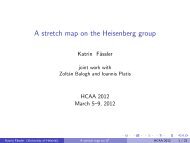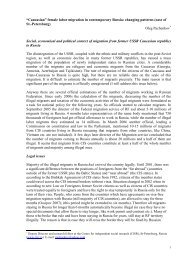THORIUM AS AN ENERGY SOURCE - Opportunities for Norway ...
THORIUM AS AN ENERGY SOURCE - Opportunities for Norway ...
THORIUM AS AN ENERGY SOURCE - Opportunities for Norway ...
You also want an ePaper? Increase the reach of your titles
YUMPU automatically turns print PDFs into web optimized ePapers that Google loves.
Thorium as an Energy Source - <strong>Opportunities</strong> <strong>for</strong> <strong>Norway</strong><br />
the one hand improves the thermodynamic efficiency and on the other hand in some cases allows<br />
the production of hydrogen with a thermo-chemical process to dissociate water.<br />
System<br />
GFR<br />
(Gas-cooled Fast Reactor)<br />
LFR<br />
(Lead-cooled Fast Reactor)<br />
MSR<br />
(Molten Salt Reactor)<br />
Table 5.5: Overview of Generation IV Systems (Source: GIF 2007 annual report).<br />
SCWR<br />
(Super Critical Water-cooled Reactor)<br />
SFR<br />
(Sodium-cooled Fast Reactor)<br />
VHTR<br />
(Very High Temperature gas Reactor)<br />
Neutron<br />
spectrum<br />
Coolant Temp. °C<br />
Fuel<br />
cycle<br />
fast helium 850 closed 1200<br />
fast lead 480 - 800 closed<br />
epithermal<br />
thermal /<br />
fast<br />
fluoride<br />
salts<br />
water 510 - 550<br />
700 - 800 closed 1000<br />
open /<br />
closed<br />
fast sodium 550 closed<br />
Size (MWe)<br />
20 - 180,<br />
300 - 1200,<br />
600 - 1000<br />
300 - 700<br />
1000 - 1500<br />
30 - 150,<br />
300 - 1500,<br />
1000 - 2000<br />
thermal helium 900 - 1000 open 250 - 300<br />
GFR – The main characteristics of the Gas-cooled Fast Reactor are self-generating cores with fast<br />
neutron spectrum, robust refractory fuel, high operating temperature, high efficiency electricity<br />
production, energy conversion with a gas turbine, and full actinide recycling possibly associated<br />
with an integrated on-site fuel reprocessing facility. A technology demonstration reactor needed<br />
to qualify key technologies could be put into operation by 2020.<br />
LFR – The Lead-cooled Fast Reactor system is characterized by a fast-neutron spectrum and a<br />
closed fuel cycle with full actinide recycling, possibly in central or regional fuel cycle facilities.<br />
The coolant could be either lead (most likely option), or lead/bismuth eutectic. The LFR can be<br />
operated as: a breeder; or a burner of actinides from spent fuel, using inert matrix fuel; or a<br />
burner/breeder using thorium matrices. Two size options are considered: a small transportable<br />
system of 50 to 150 MWe with a very long core life; and a large system of 300 to 600 MWe. In the<br />
long term, a very large system of 1200 MWe could be envisaged. The LFR system could be<br />
deployable by 2025.<br />
MSR – The Molten Salt Reactor systems present the very special feature of a liquid fuel. MSR<br />
concepts, which can be used as efficient burners of transuranic 6 elements (TRU) from spent LWR<br />
fuel, have also a breeding capability in any kind of neutron spectrum (from thermal to fast), when<br />
using the thorium or fast spectrum U-Pu fuel cycle. In both options, they have a very interesting<br />
potential <strong>for</strong> the minimization of radiotoxic nuclear waste.<br />
SCWR – Supercritical Water-Cooled Reactors are a class of high temperature, high pressure<br />
water-cooled reactors operating with a direct cycle and above the thermodynamic critical point of<br />
water (374°C, 22.1 MPa). The higher thermodynamic efficiency and plant simplification<br />
opportunities af<strong>for</strong>ded by a high-temperature, single-phase coolant translate into improved<br />
6 Transuranic Elements (TRU) are elements with atomic numbers greater than uranium.<br />
52

















